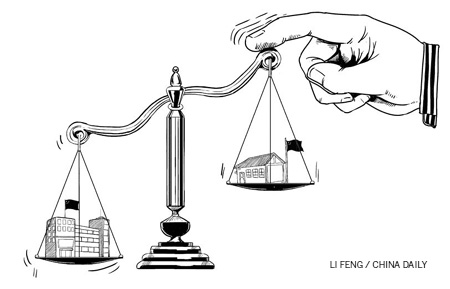
The world population has crossed 7 billion. So competition for the best educational provisions and resources will increase, especially for girls and students in poor rural areas.
Consequently, there is a risk of education improving in cities and the education gap between rural and urban areas widening further. If China seeks to deliver good quality and relevant education to all, it has to make major reforms to ensure that access to and quality of education are improved for the poor. To address this challenge, China has increased education funding considerably in recent years and introduced long-term reforms to enhance quality of and fairness and equity in education.
The issue of fairness in education is vital and relates to unequal opportunities, highlighted by significant differences in admission rates for top universities between rural and urban students. It relates also to the need for fair assessment of students and schools both.
Chinese leaders in recent and past times have overcome the disadvantages of poor rural origins to achieve extraordinary success. But behind almost every story is the essential influence of not only individual personal qualities, but also the good fortune of finding an excellent teacher or school to support a student's progress.
Making good progress at school is key to finding a route out of poverty for many rural students; it is also a key indicator of school quality. But in China, the quality of a school is not measured by students' progress at school. In contrast, it is typically evaluated on the basis of only raw examination scores.
The problem with this approach is that rural schools with disadvantages tend to be judged unfairly, while complacency is possible when it comes to schools with more able students. And it's very difficult to know where the best educational practices are achieved despite limited resources, especially in rural areas.
Some countries, however, have achieved progress in developing "value added" measures to provide a fairer and more accurate approach to evaluating schools' performance not only on exam results. Essentially, the "value added" concept is based on the idea of measuring students' progress, usually in academic results such as reading or mathematics. But the concept can also be applied to other outcomes such as attitudes, well-being or vocational qualifications of students.
Of course, as students grow older one would expect progress to be made and average attainment levels to rise. What is of interest is the extra value added by schools to students' achievements over and above the improvement normally expected. "Value added" measures thus seek to establish whether students in some schools make relatively more or less progress than those in other schools over a specified period.
Schools demonstrating higher quality are those in which students' progress exceeds expectations. Crucially, if "value added" measures were applied in different Chinese regions, this information would greatly help in identifying more accurately the under-achievement of rural or other disadvantaged students, and in improving equity by targeting resources to schools and students most in need of support.
Recently, the University of Bristol, United Kingdom, and the China National Institute for Educational Research, funded by UKAID, piloted the use of new approaches to school evaluation in more than 120 senior secondary schools across eastern and western China.
The findings show that significant differences exist both between and within Chinese schools in terms of "value added" measures. Crucially, these measures present a different picture of education quality in comparison to the raw exam scores. Teachers, students and other stakeholders were interviewed and reported that "value added" measures would indeed provide a more rigorous and welcome addition to the current school evaluation systems, but they need to be adapted to local priorities and contexts.
It is also important to raise awareness of data quality and the limitations of the measures and this would involve widespread and comprehensive training to support teachers' use of the new evaluation concepts. Differences in examination systems between provinces and cities (particularly at lower educational levels) means that creating a national "value added" system will be difficult, although such systems are feasible for regions or cities, potentially within a nationally agreed framework.
The key message is that a first step to improving education quality and equity in rural areas is through improving monitoring and evaluation systems. The evidence indicates that providing "value added" data to policymakers and practitioners will improve evaluation processes at all levels of the education system - national, regional, county, school, class and learner.
Of course, monitoring by itself doesn't improve performance. If appropriate systems were in place, teachers could collaborate in using the evidence to identify and implement the best strategies for promoting students' learning and equity, tailored to the local context, thereby also promoting teacher development, school self-evaluation and the development of schools as professional learning communities.
Across a territory as vast as China's, it is clear that more rigorous and scientific approaches are needed to design the best evaluation and improvement strategies suited to the country's wide ranging socio-cultural contexts and economic realities to give all young people a fair chance to acquire necessary skills, competence, values, knowledge, and experience they need for lifelong learning and to be active and productive citizens.
The author is a professor at the Graduate School of Education, University of Bristol, UK.
(China Daily 11/22/2011 page9)